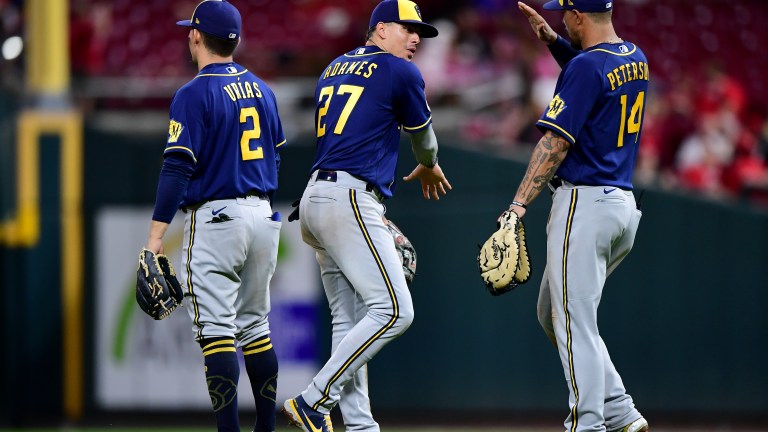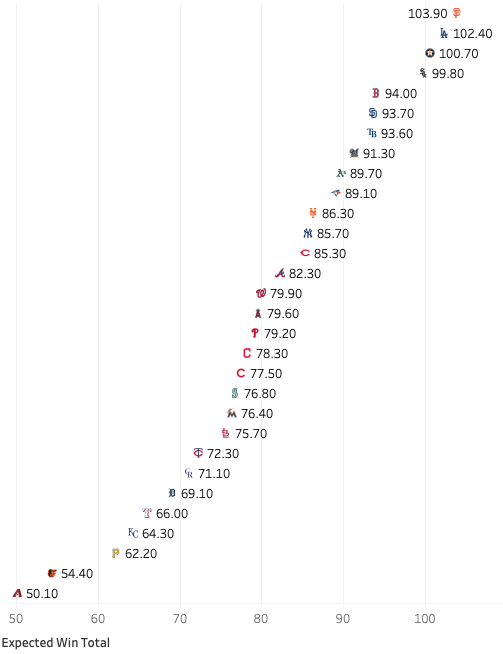MLB Second Half Team Projections: Who Should Buy or Sell?
Using the data to assess where teams stand heading into the deadline.

As the second half begins, teams will be assessing their playoff chances heading into the trade deadline. Let’s attempt to predict end of season win totals by using pythagorean win expectancy and remaining strength of schedule while leveraging expected win totals to predict each deadline approach.
Pythagorean Win Expectancy
Before we get into the results of the projections, let’s get into how pythagorean win expectancy is calculated and why it can be trusted for predicting end of season win totals. The formula for pythagorean win expectancy is as follows:
Win Expectancy = (Runs Scored^2)/(Runs Scored^2) + (Runs Against^2)
This produces a percentage that closely resembles winning percentage. The basic idea behind the pythagorean win expectancy formula is that run differential provides a better prediction of future record than current record does. Teams under-perform and over-perform their pythagorean projections each season, but over a large sample, a team’s record will approach their pythagorean win expectancy.
For this analysis, I made some tweaks to the traditional pythagorean win expectancy formula to hopefully improve the accuracy of the results. The formula I used to derive expected win percentage is as follows:
Win Expectancy = (Weighted Runs Created^1.83)/(Weighted Runs Created^1.83) + (Runs Against^1.83)
Baseball Reference recommends changing the exponent from 2 to 1.83. It has been shown to decrease the margin of error in the predictions. The second change I made is changing runs scored to weighted run created as an offense. Weights Runs Created or wRC is the statistic that creates wRC+ and measures a player’s total offensive impact in the form of runs created. It gives a more accurate representation of offensive performance than runs scored and thus is used in my formula.
Plugging each team’s wRC and runs against in the formula above produced an expected winning percentage. In order to get a total end of season win value, I multiplied expected winning percentage times each teams remaining games and then added that total to their current win total. For example, the Red Sox have an expected win percentage of .550 and 71 games remaining as well as 55 current wins. The formula for the Red Sox total wins is (.550 * 71) + 55 = 94 wins.
Win Total Projections
Below are the results of the expected win totals calculated using the formulas from above:

These projections are not perfect as they do not predict for injuries, strength of schedule and potential trades as the deadline nears, but they account for the most important factors for winning games. Strength of schedule has a large impact on baseball teams, especially because half of games played are against division rivals. Playing in a division with poor competition can inflate win totals and vice versa.
Strength of Schedule
Teams can outperform and underperform their expected win totals by encountering an easy or hard schedule. Thanks to the wonderful folks at Power Rankings Guru, we have access to live updated power rankings as well as updated strength of schedule rankings. Their strength of schedule statistic is calculated by averaging the power ranking of teams faced into one composite strength of schedule score, so a higher score indicates an easier schedule and a lower score indicates a harder schedule. The strength of schedule scores for the second half are shown below:

Unsurprisingly, the Cubs and Reds, who both play in the lowly NL Central, have the weakest second half schedules. The NL Central currently has three teams below .500. The Reds will benefit heavily from an easy schedule and present themselves as serious wild card contenders that could outperform their expected win total. The White Sox, who benefitted from having the easiest first half strength of schedule, will have the fourth easiest second half schedule. They are well on their way to winning 100 games if they continue to dominate the Tigers, Indians, Royals and Twins. It is surprising to see the Astros face such an easy schedule in the second half, and could propel them to finishing the season with the best record in baseball above even the Dodgers and Giants.
It is no secret that the AL East is the best division in baseball. The Red Sox, who have the fifth hardest second half schedule, will face a tough challenge as 26 of their first 32 games to begin the second half are against the Yankees, Blue Jays and Rays. If the Red Sox escape winning more than half of those games, they should have a clear path to taking first place in the AL East, but it is very likely that the AL East champion will be fighting till the last day of the season. The top four AL East teams are within eight wins in the projected win totals. It’s anyone’s race, even the Yankees.
Trade Deadline Implications
As the July 31st trade deadline approaches, teams will be assessing their current state of play as well as playoff chances to make the crucial decision of giving up on the season and shipping pieces to other teams for prospects or trading their prospect capital for win-now upgrades. The win total projections present four tiers: the front runners, the wild card chasers, the teams in limbo and the teams out of contention entirely. For reference, here are the projections again:

Tier One – The Front Runners – Giants, Dodgers, Astros, White Sox
The cream of the crop. These four teams, two of which from the NL West, will be competing for the best record in the league and a chance at securing a World Series title. There are rumors of the Dodgers being heavily involved in acquiring Kris Bryant.
The White Sox are confident that star players, Luis Robert and Eloy Jimenez will be returning to the lineup before the end of the season. Nick Madrigal went down with a season ending torn hamstring, so look for the White Sox to be on the market for a second basemen. Surprisingly, the star studded White Sox bullpen has a 4.28 ERA since June 1, so an aggressive upgrade could push them over the top as World Series contenders. The Astros, with Ryan Pressly and Christian Javier as their top relievers, should actively be shopping the reliever market as well.
As much as Giants fans are pleading for President of Baseball Ops, Farhan Zaidi, to make a splash at the deadline, it is likely that Zaidi has both the present and the future success in mind. Zaidi will be looking to make cheap upgrades without forfeiting top prospects.
Tier Two – The Wild Card Race – Red Sox, Padres, Rays, Brewers, Athletics, Blue Jays, Mets, Yankees, Reds
The second tier is where things start to get interesting. Five teams will be vying for three spots in the AL Wild Card race, but it remains to be seen if the Yankees will be buyers in a last ditch effort to save their season or stay stagnant till 2022. The Red Sox will be in the hunt for an impact second basemen like Eduardo Escobar or Jonathon Schoop, but if the price is too high then Boston will stick with Christian Arroyo (106 wRC+) and go after bullpen help like the rest of the wild card contenders.
There is not a more interesting team than the Cincinnati Reds heading into the deadline. They find themselves four games back of San Diego for the second wild card spot, and five games back of the Brew Crew for first place in the NL Central. They will surely be looking to add impact bats to an already stacked lineup. Our very own Aram Leighton surmises that Cinci could be a potential landing spot for Trevor Story.
Tier Three – In Limbo – Braves, Nationals, Angels, Phillies, Indians, Cubs, Mariners, Marlins, Cardinals
The Braves began the trade deadline madness by acquiring Joc Pederson from the Cubs after a devastating injury to superstar Ronald Acuna Jr. The Braves have been through it all this season, dealing with injuries galore (Acuna, Ynoa, Soroka, d’Arnaud) and as a preseason favorite in the NL east, the Braves are feeling desperate to keep their postseason hopes alive.
Braves GM Alex Anthopoulos is adamant about the Braves adding payroll at the deadline and making a push to catch the Mets, who have a 4.0 game lead on the Braves for first place. The Phillies and Nationals, who are also built to contend in the NL East, are 3.5 and 6.0 games back of the Mets respectively and will be scouring the trade market looking to add around their young cores.
The Angels find themselves in a weird situation being 9.0 games back of first and 5.5 games back of the second wild card spot, but with Mike Trout returning soon and MVP front runner Shohei Ohtani leading the league in homers, it would be shocking if the Angels didn’t make a few additions.
The Cubs, Mariners, Marlins and Cardinals will all be looking to ship out expiring contracts to competitive teams to increase prospect capital, but the Indians seem to be in limbo of all limbos. Cleveland made efforts to partially sell this past offseason sending Francisco Lindor to the Mets and Mike Clevinger to the Padres in hopes of building their farm system and adding young MLB ready talent.
That strategy has backfired as the Indians are 4.5 games back of the wild card and 8.0 games back of first place. Josh Naylor, Owen Miller, Cal Quantrill, and Andres Gimenez have all struggled in the majors this season after being acquired. Shane Bieber and Jose Ramirez are two of the best players in baseball on cheap contracts. The Indians have attempted and failed to put offensive pieces around their stars and are now in a position to neither sell nor buy at the deadline.
Tier Four – Out of Contention – Twins, Rockies, Tigers, Rangers, Royals, Pirates, Orioles, D-Backs
And now here are the true sellers of the deadline. These eight teams will be shopping any aging and expiring pieces in an attempt to reclaim even pennies on the dollar. Jose Berrios, Trevor Story, Joey Gallo, Whit Merrifield, Adam Frazier, Eduardo Escobar and maybe even Ketel Marte will highlight the trade deadline. It’s going to be action packed.

